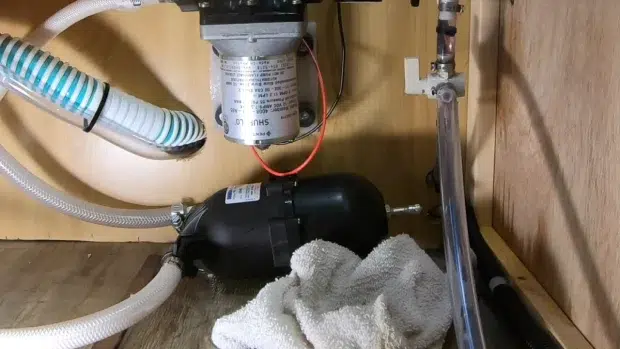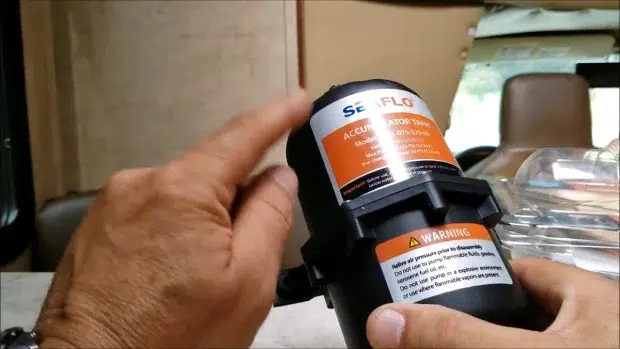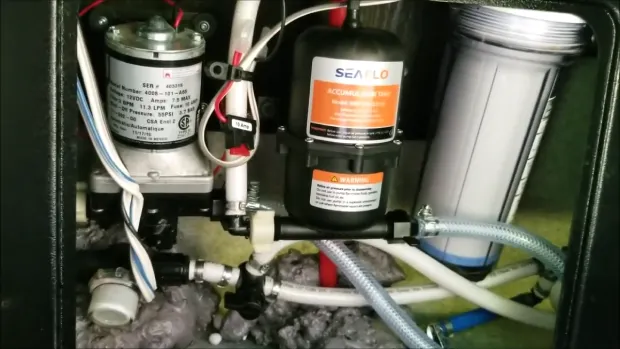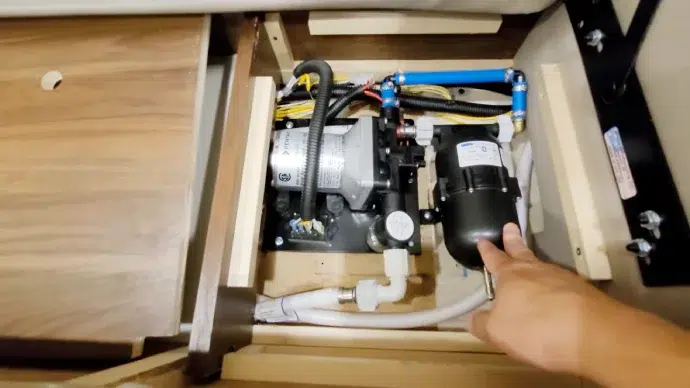Last Updated on September 19, 2023
As the popularity of recreational vehicles (RVs) continues to grow, many owners are faced with a common question: do I need an accumulator tank in my RV? An accumulator tank is a device that helps regulate water pressure and flow in RV plumbing systems.
While some RVers swear by their use, others find them unnecessary or problematic. One significant benefit of using an accumulator tank in an RV is improved water pressure consistency.
Without an accumulator tank, water flow can be inconsistent due to changes in demand and fluctuations in pump operation. This can result in weak showers or slow filling times for sinks and toilets.
Today we will intensely discuss why you need an RV accumulator tank to provide consistent water pressure throughout the RV water system.
Why Do You Need an Accumulator Tank in Your RV?

The RV Accumulator Tank is vital to any recreational vehicle’s water supply system. This innovative device is designed to reduce the pulsations and water-hammering effects that often occur when water is pumped through pipes.
Here are some critical reason why should your RV have one:
#1 Reducing Water Hammer
Water hammers are a common problem in RV plumbing systems that can lead to unnecessary noise. The sudden stoppage of water flow causes pressure spikes, resulting in a loud banging sound.
One solution for reducing water hammering is the installation of an accumulator tank. An accumulator tank works by providing additional space for pressurized water. When you turn on your tap or shower, water flows into the tank instead of immediately flowing through the pipes.
As more water enters the tank, it compresses the air inside, creating a cushioning effect that reduces pressure fluctuations throughout your system. This helps reduce or eliminate water hammer while also prolonging the lifespan of your RV’s plumbing.
While not necessary for every RV owner, those who experience frequent water hammers may benefit from installing an accumulator tank. It is important to note that improper installation or sizing of an accumulator tank can cause further issues, such as leaks or reduced efficiency.
#2 Preventing Pump Damage
An accumulator tank is essential to a recreational vehicle’s plumbing system. It helps prevent pump damage and ensures consistent water pressure throughout the RV. Without an accumulator tank, the pump has to work harder to maintain a steady flow of water, leading to wear and tear on the pump motor.
Moreover, prolonged use without an accumulator tank can cause frequent cycling of the pump, which results in unnecessary noise and vibration.
This cycling also wastes energy since it causes the pump to turn on frequently even when no water demand exists. To avoid such issues, installing an accumulator tank is highly recommended.
#3 Conserving Water
An accumulator tank is an essential piece of equipment that can help. It helps save water and enhances your experience by providing steady pressure and reducing pump cycling.
This tank works by storing water under pressure from the pump and releasing it gradually instead of all at once. This means that you’ll have more control over how much water you use, reducing wastage and increasing efficiency.
By having consistent pressure delivered to faucets and showerheads, there will be less need for adjustments, leading to fewer spills and leaks. Also, reduced pump cycling means lower energy consumption, which saves money in the long run.
#4 Maximize Efficiency
As previously mentioned, the tank reduces wear and tear on the pump system by allowing it to turn off and on less frequently. This extends the pump’s lifespan and saves energy as less power is required for occasional usage.
Furthermore, because the accumulator tank stores a certain amount of pressurized water, users can use their RV’s water system without running the pump constantly.
This means that even if small leaks in the plumbing or faucets are left slightly open, enough stored water will still be available for basic tasks such as washing dishes or brushing teeth. In this way, an accumulator tank can help conserve water while maximizing its usage.
#5 Quieter Operation
Another benefit of using an accumulator RV tank in an RV’s water system is quieter operation. With the pump turning on and off less frequently, there will be less noise pollution generated by the constant humming of the motor.
This can make for a more peaceful and enjoyable environment inside the vehicle, especially during nighttime hours when loud noises can disrupt sleep.
In addition to reducing overall noise levels, an accumulator tank also helps eliminate the sudden bursts of sound that occur when a faucet or showerhead is turned on at full pressure.
Without an accumulator tank, these quick changes in water flow can cause vibrations throughout the pipes, translating into loud banging sounds known as ‘water hammer.
Drawbacks of an RV Accumulator Tank

The installation of an accumulator tank in an RV can help you with a lot of benefits but there are some cons too.
Installation Cost
The cost of an accumulator tank can be a drawback for some RV owners. While the initial investment may seem reasonable, additional costs can quickly increase.
Installation costs can vary depending on whether or not you choose to do it yourself or hire a professional. In addition, maintenance and repair expenses should also be taken into consideration.
Furthermore, investing in an accumulator tank may not make sense financially if you only use your RV for short trips throughout the year. The cost-benefit analysis will depend on how often and long you use your RV.
Maintenance
Accumulator tanks are prone to sediment buildup and corrosion due to exposure to water and air, which can lead to leaks or reduced pressure over time. The tank must be regularly cleaned and inspected for damage or wear.
Furthermore, repairing a faulty accumulator tank can be costly. If not maintained properly, the tank’s lifespan may be significantly reduced, leading to premature replacement costs. Also, finding replacement parts for older models can sometimes be challenging, causing further expenses.
Installation Space
Another drawback of an accumulator tank is the amount of space it takes up in an RV. Since these tanks can vary, they may be too large for some vehicles with limited storage capacity.
Also, even if an RV has enough room to accommodate a larger accumulator tank, this may come at the expense of other valuable storage or living space.
Furthermore, installing an accumulator tank requires careful consideration of where to place it within the vehicle. The location must allow easy access during maintenance and repairs while not interfering with other components, such as plumbing or electrical systems.
Alternatives to an RV Accumulator Tank
Here are some alternatives to an RV accumulator tank:
#1 Pressurized Water Tanks
Pressurized water tanks are an alternative to an accumulator tank in your RV. These tanks store and pressurize the water, providing a consistent pressure flow throughout the system.
This means that you can enjoy a steady stream of water without experiencing any fluctuations in pressure. One benefit of using a pressurized water tank is that it reduces the need for an accumulator tank altogether.
#2 Water Pressure Regulators
Another alternative to using an accumulator tank in your RV’s plumbing system is a water pressure regulator. Water pressure regulators reduce the incoming water pressure from the campground or city supply to a safe and consistent level for your RV’s system.
High water pressure can cause damage to pipes, fittings, and appliances, making it important to regulate the flow of water. Installing a water pressure regulator protects your RV’s plumbing system and ensures all fixtures receive appropriate water flow levels.
Is an RV accumulator tank right for you?
An accumulator tank is a storage vessel that helps regulate water pressure within your RV’s plumbing system by storing excess water from the pump when not in use.
When a faucet is turned on, instead of relying solely on the pump to provide enough pressure, the accumulated tank’s stored water can help maintain consistent flow until the pump catches up.
An accumulator tank may be right if you frequently experience low or fluctuating water pressure while using your RV’s plumbing system.
Here are three scenarios where an accumulator tank could make all the difference:
- Boondocking: If you enjoy camping off-grid without access to city water, having an accumulator tank can ensure consistent water pressure even if your pump has trouble keeping up.
- Multiple users: If multiple people use your RV’s plumbing system at once (e.g., showering while someone else washes dishes), an accumulator tank can prevent drops in pressure as each person uses various faucets simultaneously.
- Water-saving devices: Some RVers install low-flow fixtures or other high-efficiency appliances to conserve water usage. These devices are great for saving resources.
Does an RV accumulator tank increase water pressure?

Contrary to popular belief, an RV accumulator tank does not serve to increase water pressure. Rather, it maintains the system’s pressure within its optimal range.
The accumulator tank is a pressure storage unit that absorbs water pressure surges due to the water pump’s cycling on and off, thus preventing water hammering and reducing pump noise.
Therefore, an accumulator tank is used to provide a constant water flow rate, prevent pump fatigue, and save energy by allowing the pump to work intermittently.
What pressure should my RV accumulator tank be set at?
The optimal pressure to set your RV accumulator tank at is around 30 psi. However, the pressure setting may vary depending on the manufacturer’s recommendations or the specific needs of your RV.
Ensuring that the accumulator tank’s pressure is set within the recommended range for your RV’s water system is crucial. If the pressure is too low, the accumulator tank will not function effectively, while if the pressure is too high, it can cause damage to the RV’s water system, leading to leaks, burst pipes, or even water damage.
Thus, you must consult your RV’s manual or a professional technician to determine the correct pressure setting for your RV accumulator tank.
Choose Wisely Considering Benefits and Drawbacks of RV Accumulator Tanks
An accumulator tank can provide numerous benefits for RV owners, including reducing water hammer and preventing pump damage. It can also conserve water by allowing for a steady flow without constantly turning on and off the pump.
However, there are potential drawbacks, such as space considerations and cost. For those with limited space in their RV or who do not want to invest in an accumulator tank, alternative options exist, such as adding a pressure regulator or upgrading the current pump system.
In the end, whether an accumulator tank is right depends on your needs and preferences. Considering the benefits and drawbacks of an accumulator tank can help RV owners decide whether it is necessary for their specific situation.


